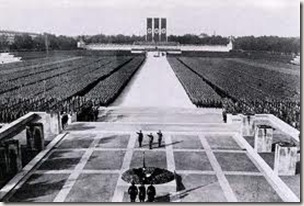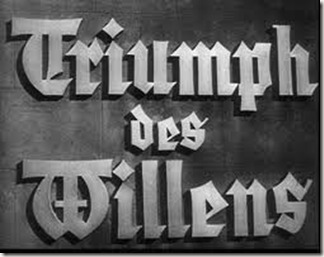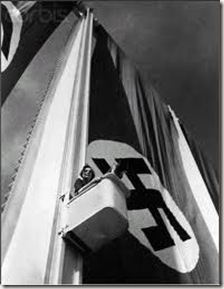With this post The Biennial Project is excited to unveil a regular new feature – reports from Biennial Project Special Correspondents on interesting and important exhibits around the world.
And where better to start than with a report from Berlin – the coolest art town ever!
We are incredibly fortunate to have as our Berlin Correspondent the internationally renowned artist and critic N. Ami.
Her future reviews will cover upcoming Berlin shows featuring the work of Nan Golden, Sigmar Polke and Robert Mapplethorpe,
but for her inaugural piece she sends us a thought-provoking review of a show that looks right into the heart of recent German history……

Hitler has new solo show in Berlin
Support documentary wins
Venice Biennial Gold Medal.
by N. Ami
[N. Ami is an American journalist living in Berlin, and a big fan of the Biennial Project.]
Hitler and the Germans: Nation and Crime.
Exhibition at the German Historical Museum, Berlin.
Autumn 2010 through February 2011
My German friends said I should probably go see this show. It had a long, extended run. I put it off as long as possible. OK, so I finally went.
I don’t like to think about Hitler. Nor does anyone I know, here in Berlin or in the States. Display of a swastika is forbidden in Germany (except in something like this museum show or a dramatization), and it is a punishable offense to deny the facts of the Holocaust.
This show was dead serious. World War II ended 66 years ago, and Hitler died 66 years ago. But people here still have to live with him.
Berlin has buildings everywhere, half-bombed-out from the war, not yet rebuilt. There is a special bomb squad trained only for dismantling the World War II -type U.S. and British bombs that are still often found in construction sites.
Every German family has a story about what the parents or grandparents were doing under Hitler. In Berlin, and in many other German cities, there are bronze memorials set in the sidewalks noting where people were pulled out of their homes and killed. It’s hard not to see daily reminders of Hitler. But I’m glad I went to this show.
Massive Exhibition
The German Historical Museum is a huge complex. This exhibition was in the new part, designed by I.M. Pei. Most artifacts were from the collection of this museum. There were about 600 exhibits and over 400 posters and photos. Each separate exhibit often had as many as 20 items in it. There were thousands of objects and lots of text.
I saw more swastikas in one day than I had seen before in my entire lifetime. And I saw more depictions of Hitler than I could possibly bear.
There were photos and newsreel footage from the concentration camps. There was an example of every possible Nazi uniform and military decoration. There was every available type of Hitler artifact, sometimes diabolical propaganda, sometimes outright kitsch. There were Hitler lamps. Hitler radios. Maps. Charts. Speeches.
And importantly, whenever possible, evidence of resistance movements was included.
Huge Turnout
The exhibition space had clean lines, and each separate section had plenty of room. But the route through it was maze-like. In an hour I felt like my head would explode. The place was jam-packed -- all nationalities, all ages.
There were many school groups, teenagers. I wondered what the young people thought. Their grandparents could have been in these photos. I wondered what the people in their 80s thought. They could have been young adults and soldier-age under Hitler.
Hitler and his Artists
I became aware that these sinister artifacts were often beautifully designed and crafted. Design does not happen by magic. Let’s say that Hitler somehow got a lot of artists and craftspeople on his side.
What were those artists thinking?
And let me just mention filmmaker Leni Riefenstahl. Her1935 documentary “Triumph of the Will” was not screened during this show (it is 1hr 50 minutes), but was discussed in depth in the exhibition catalog. **
Biennial Gold Medal!
Lavishly funded by the Nazi Party, “Triumph of the Will” was, in a sick way, remarkable art. Some say it is the best propaganda film ever made. It won Venice Biennial, Gold Medal, 1936; German Film Prize, 1935; World Exhibition (Paris), Grand Prize, 1937. Biennial fans: be careful what you wish for.
Riefenstahl’s final shooting ratio was 1:42. She had 18 cinematographers along with their assistants, 16 newsreel camera people, 9 aerial photographers, and a full staff of 170 people. It is said that her crew dressed in military uniforms to blend in with the crowds.
Due to the her huge “success” with Nazi propaganda, Riefelstahl went through a long period of disgrace after Hitler’s downfall. Then she somehow resurrected her career and went on to make more films. She became pals with folks like Siegfried and Roy, and Mick Jagger. She died in Germany recently (2003) at age 101.
If you haven’t seen this film, it’s worth doing once. To watch “Triumph of the Will” with subtitles (it’s mostly music with no dialog), see:
http://video.google.de/videoplay?docid=721544746508320698#
Porsche and VolksWagen
Also regarding art and design, there were small-scale models of the earliest VolksWagen (“People’s Car”), designed by Ferdinand Porsche (yes, that Porsche) for Hitler. The first model was presented to Hitler by Porsche in 1938 on Hitler’s 49th birthday.
The original VW looked liked the early beetles we know, but were called the "KdF-Wagen" (“Kraft durch Freude“= strength through joy). They were designed to be easily built and affordable. However, car factories quickly turned to military production, and the first real VWs were not built until after the war.
The U.S. slowly wakes up
The only light moments in this show were supplied by Americans. The best were satirical images of Hitler from Hollywood films. A good example is Charlie Chaplin’s “The Great Dictator” (1940), made before the U.S. declared war and before the extent of the Holocaust was known. A continual screening of this film was included in the exhibition.
Chaplin later said that he never would have made the film, had he known the truth about Hitler’s crimes. But his satire is brilliant, at a time when the U.S. government was not yet ready to see the full threat of Hitler. See the “Globe Dance” scene from Chaplin’s film at:
http://www.youtube.com/watch?v=IJOuoyoMhj8
And a real oddity was a New York Times article from October 1944 showing 7 photos of Hitler first circulated by the U.S. Secret Service. They were “retouched to show possible disguises,” should Hitler happen to sneak out of Germany (to New York City!?) – Hitler bald without moustache, Hitler with full beard and glasses, clean-shaven with wig and business suit, and so on. In a creepy way, he looked like any regular guy.
Why??
The exhibition curators asked the question – a question now 3 generations old – why were so many Germans willing to align with Hitler and support the Nazi dictatorship? Why could a basically uncharismatic nobody become one of the most powerful leaders of the modern world? Why could the German people let this happen?
Well, the question was not answered by this show. But at least it was once again officially asked. I, for one, left with more questions than I came with. I’ll keep wondering and writing and talking to Germans. Stay tuned for future reports.
For a 3-D trip through the exhibition, see:
http://www.dhm.de/ausstellungen/hitler-und-die-deutschen/panoramen.html
[footnote]
**Philipp Stiasny, “Vom Himmel Hoch: Adolph Hitler und die ‘Volksgemeinschaft’ in Triumph des Willens’, “ Hitler und die Deutschen (Exhibition Catalog), German Historical Museum, 2010.


Editors: would that our own country were up to the task of such an unflinching assessment of what has been done in our name.
Stay tuned for more.
The Biennial Project